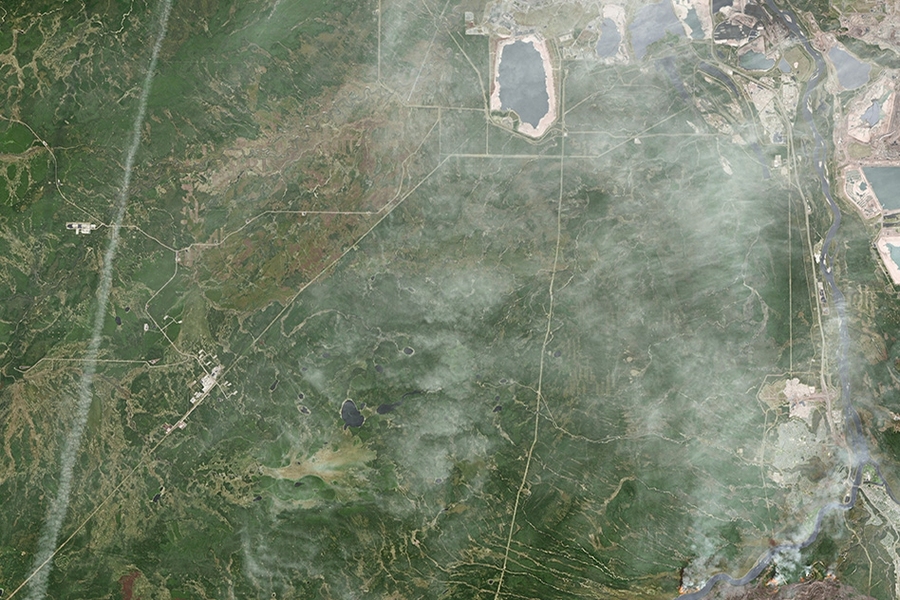Whether intentionally set to consume agricultural waste or naturally ignited in forests or peatlands, open-burning fires impact the global climate system in two ways which, to some extent, cancel each other out. On one hand, they generate a significant fraction of the world’s carbon dioxide emissions, which drive up the average global surface temperature. On the other hand, they produce atmospheric aerosols, organic carbon, black carbon, and sulfate-bearing particulates that can lower that temperature either directly, by reflecting sunlight skyward, or indirectly, by increasing the reflectivity of clouds. Because wildfire aerosols play a key role in determining the future of the planet’s temperature and precipitation patterns, it’s crucial that today’s climate models — upon which energy and climate policymaking depend — accurately represent their impact on the climate system.
But a new study in Atmospheric Chemistry and Physics by researchers at the MIT Joint Program on the Science and Policy of Global Change shows that at least one widely-used climate model is overestimating the cooling effect of these aerosol emissions by as much as 23 percent.
“This overestimation could lead to errors in projections of surface temperature and rainfall, both globally and regionally,“ says Chien Wang, a senior research scientist at MIT’s Department of Earth, Atmospheric and Planetary Sciences and the Joint Program, who co-authored the paper with two members of his group: lead author and research scientist Benjamin S. Grandey and postdoc Hsiang-He Lee of the Center for Environmental Sensing and Modeling at the Singapore-MIT Alliance for Research and Technology. “We hope our findings will reduce such errors in climate modeling.”
To make long-term global projections, most climate models represent atmospheric wildfire aerosol emissions by using monthly measures of emissions at different locations around the globe, and then averaging those emissions over multiple years — before estimating their effect on solar radiation at each location over the multi-year period. Questioning the accuracy of this conventional approach, the researchers proposed a revised representation of wildfire aerosol emissions in which the radiative effect associated with each monthly measure of emissions is first calculated, before averaging over the multi-year period. The revised approach would account for year-to-year variability in the aerosols’ radiative effect, which is missing in the conventional representation.
Using a global aerosol-climate model — the Community Earth System Model (CESM) — and the Global Fire Emissions Database (GFED4.0s), the researchers compared both modeling approaches over a 10-year period. The comparison showed that wildfire emissions are responsible for a global mean net radiative effect of about -1.26 watts per square meter for the conventional approach, and about -1.02 watts per square meter for the revised approach. The conventional climate modeling approach systematically overestimated the strength of the net radiative effect of wildfire aerosols — by 23 percent globally and by higher levels (58 percent over Australia and New Zealand; 43 percent over Boreal Asia, where wildfires are commonplace) regionally.
The researchers attribute this systematic overestimation to the non-linear influence of the aerosols on clouds, due largely to interactions between organic carbon aerosols and clouds. Organic carbon aerosols initially boost the reflectivity (and thus cooling effect) of clouds, but as concentrations increase over a particular geographic location, the rate of increase in cloud reflectivity (and cooling effect) slows down considerably. By incorrectly assuming that the indirect cooling effect of aerosol emissions increases linearly with their concentration, conventional approaches overestimate that effect in climate models.
Representing the year-to-year variability in the cooling effect of wildfire aerosols in climate models could improve our understanding of the climate system and the overall accuracy of global and regional climate projections.
“Hopefully what we’ve found here will be taken into account in future climate modeling studies, which could help improve decision-making regarding climate mitigation and adaptation,” says Grandey.
The research team recommends further research to test the robustness of their method by using different climate models and wildfire emissions data sets, improve the scientific understanding of the mechanisms behind the results, and explore in greater depth the impact of year-to-year variation in aerosol emissions on different aspects of climate change.
The research was funded by the Singapore National Research Foundation through the Singapore-MIT Alliance for Research and Technology's Center for Environmental Sensing and Modeling, as well as by grants from the National Science Foundation, the Department of Energy, and the Environmental Protection Agency.






